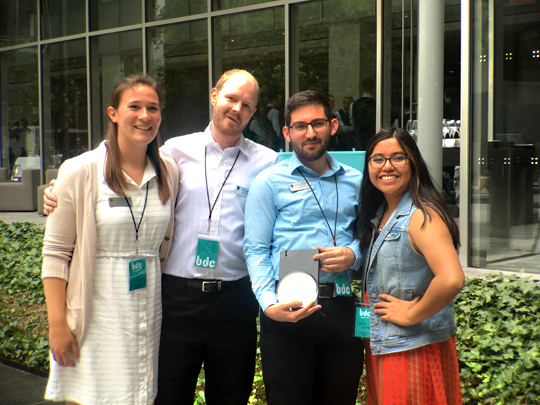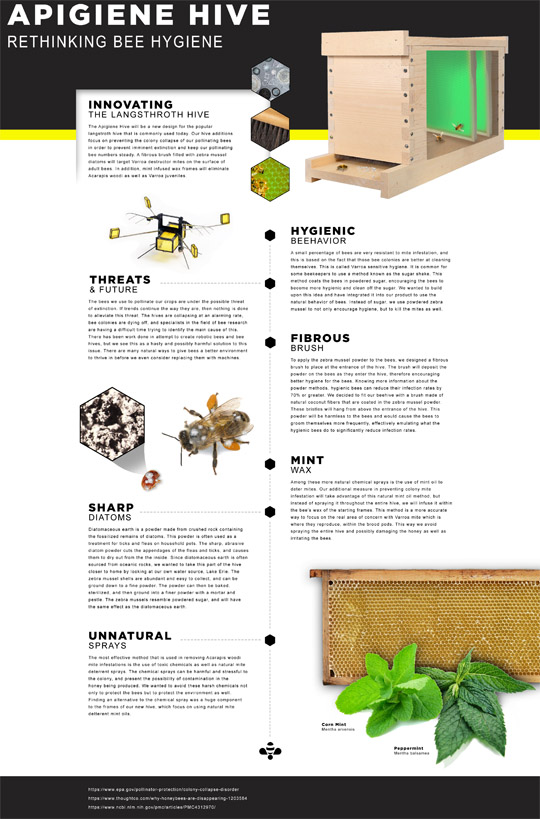UT students who thought outside — and inside — the hive won the Outstanding Field Research Award June 22 at the Biodesign Challenge Summit in New York.
“Apigiene Hive: Rethinking Bee Hygiene” was selected for the honor that recognizes a team that takes the initiative to go into the field and interview experts as well as potentially affected communities in order to find and understand the social impacts of their project.

Members of the UT team — from left, Madeline Tomczak, Jesse Grumelot, Domenic Pennetta and Lucya Keune — posed for a photo with the Outstanding Field Research Award they won June 22 at the Biodesign Challenge Summit, which was held at the Museum of Modern Art in New York.
The four were in New York for the award ceremony and exhibition with Brian Carpenter and Eric Zeigler, assistant professors in the Department of Art in the College of Arts and Letters, who taught the Biodesign Challenge class spring semester.
“We are very proud of our UT students,” Carpenter said. “This challenge is fantastic. It encourages students to think creatively, take risks, and gather science and data. They realize their designs can work.”
“This competition was such an incredible opportunity for our students,” Zeigler said. “For UT to win an award our first year in the challenge shows the dedication and creativity of our students.”
Solving problems creatively is what the Biodesign Challenge is all about. The Genspace NYC program offers college students the chance to envision future applications of biotechnology by working together interdisciplinarily.
 At UT, the Biodesign Challenge class brought together students majoring in art, bioengineering and environmental science, as well as peers from the Jesup Scott Honors College.
At UT, the Biodesign Challenge class brought together students majoring in art, bioengineering and environmental science, as well as peers from the Jesup Scott Honors College.
UT went head to head against 29 schools from across the United States, Australia, Belgium, Canada, Colombia, France, Guatemala, Japan and Scotland. Six awards were presented at the challenge.
“This was an incredible win on a world stage. Our students competed against teams from New York University, Rutgers, the University of Sydney, the Illinois Institute of Technology, Ghent University, Rensselaer Polytechnic Institute, Georgetown. It was our first time out of the gate, and UT took an award,” said Barbara WF Miner, professor and chair of the UT Department of Art. “We are ecstatic!”
“[The 30] finalists were selected from a pool of 450 participants,” Daniel Grushkin, founder and director of the Biodesign Challenge, said. “I firmly believe that they are leading us into a sustainable future with their visions.”
The UT team wanted to help the bee population and created additions for the popular Langstroth hive to fight one of the insect’s biggest foes: mites.
A fibrous brush filled with zebra mussel powder at the hive entrance targets Varroa destructor mites on the surface of adult bees. The insects will clean off the powder — and the mites — and leftover powder will help kill the intruders inside the hive.
And to tackle the Acarapis woodi mites, which invade the hive and lay eggs, the team turned to a natural deterrent: mint, which was infused with the wax frames.
At the Museum of Modern Art in New York, the UT students presented their project to more than 200 scientists, designers, entrepreneurs and artists.
“Our students’ design is economically feasible; beekeepers would just add two simple modifications to their existing hives,” Zeigler said. “It’s a happy solution, and one that could have tremendous market impact all over the world.”
“Eric, the students and I want to thank the University for its support,” Carpenter said. “We wouldn’t have been able to develop this class without assistance from the College of Arts and Letters; the Jesup Scott Honors College; the College of Engineering; the Department of Art; and the Department of Environmental Sciences. We’re already looking forward to next year’s challenge.”